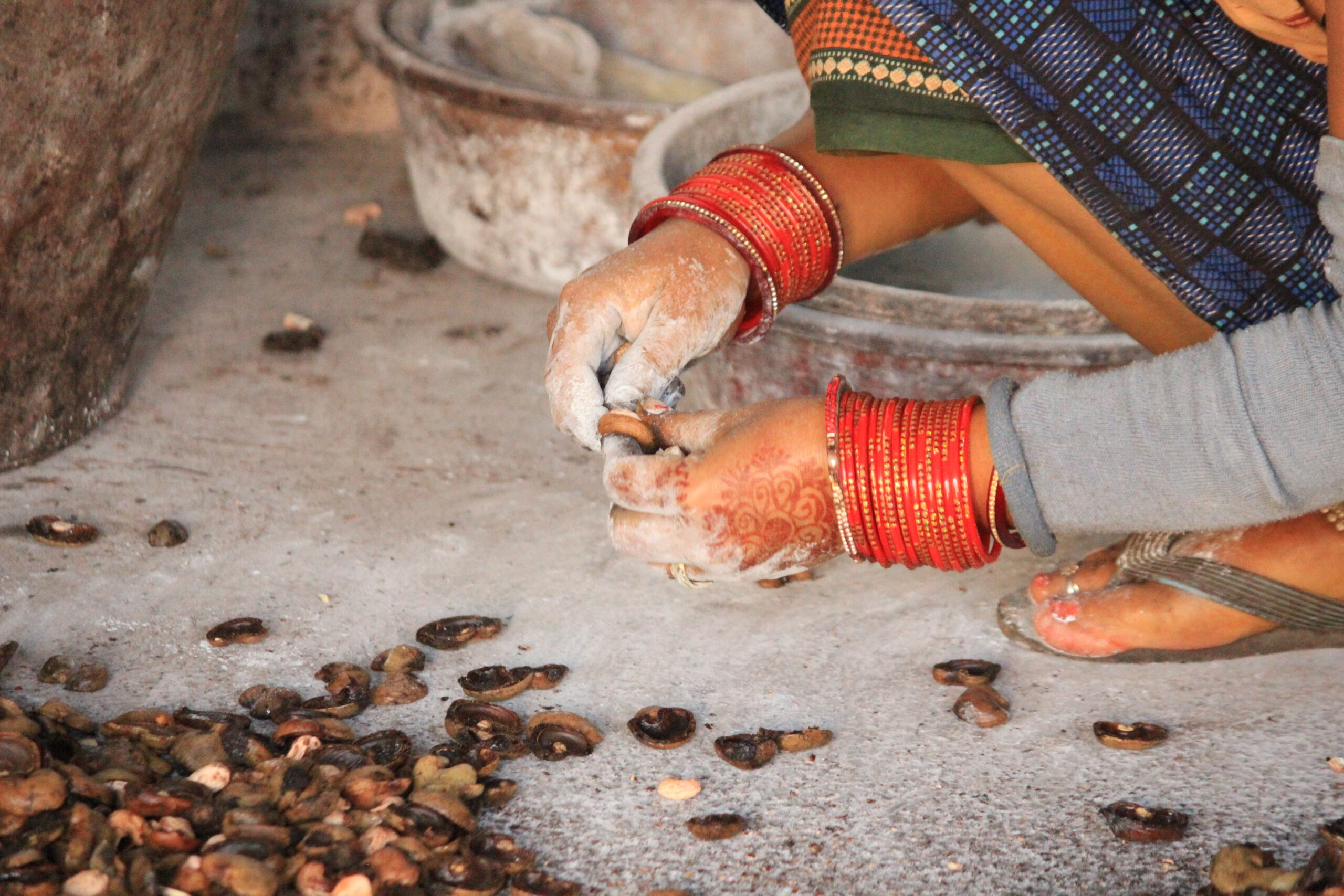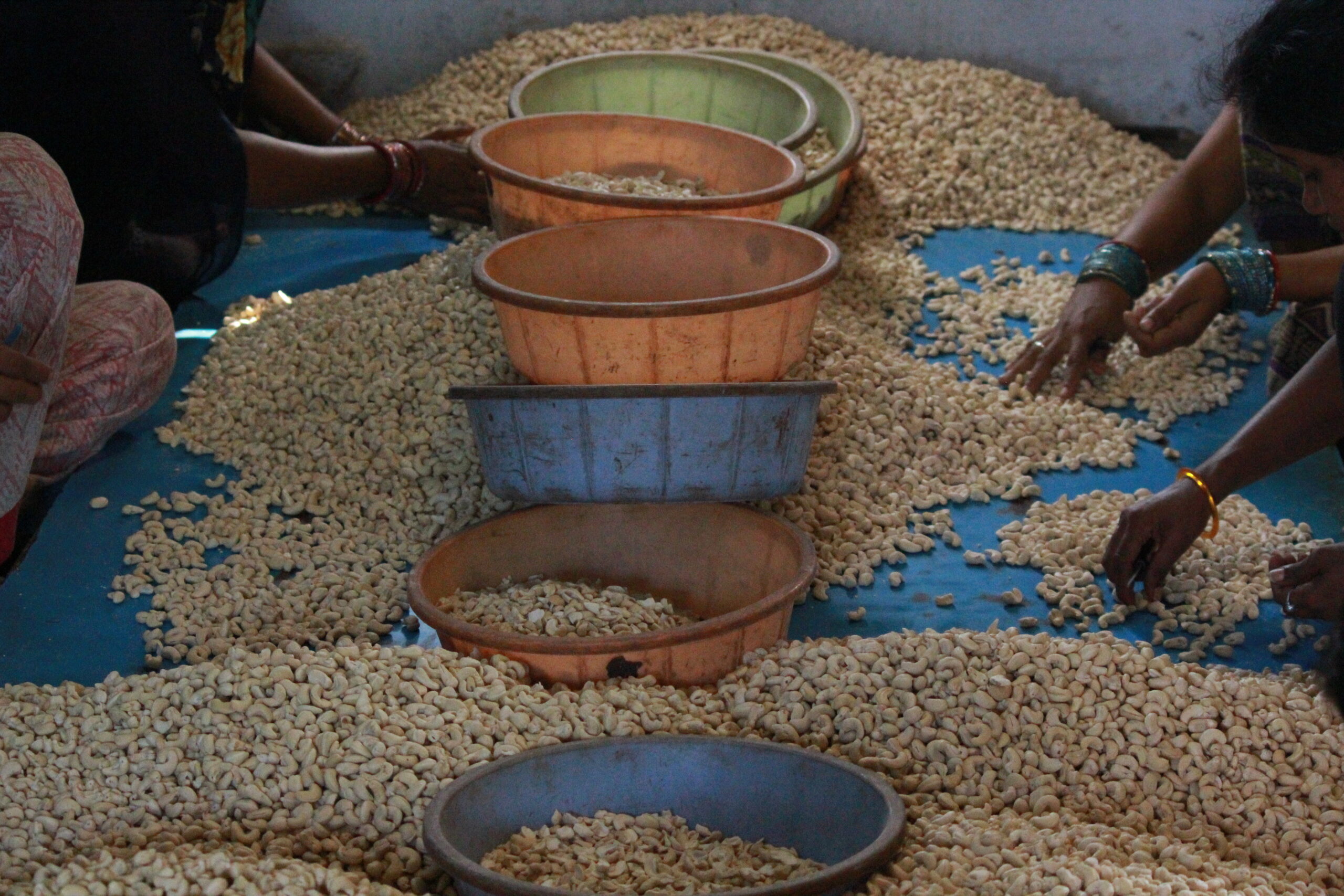Text and Visuals By: Anushree Goenka
Editors: Riya Singh Rathore and Soumya Singhal
“We rub our hands with ash to reduce the corrosive impact of the cashew nut oil on our skin,” says 43 year old Nagamma as she periodically powders her hands. She continues shelling and extracting the previously roasted cashew nuts that lie in a pile next to her. Her discoloured hands look henna stained from afar as they strip the cashew husks for hours on end. During the lunch hour, Nagamma and a few other workers stretch and discuss their aching bodies after hours of crouching and husking the nuts. The workers eat, use the toilet, and rest for a little before returning to work.

Most women rub their hands with ash before shelling the nuts to reduce the contact dermatitis caused by the cashew nut shell liquid.
After nearly a week of building a good rapport, I was allowed to enter a cashew factory. Ganjam, a coastal district in the eastern state of Odisha, has a significant area under cultivation and is one of the state’s major hubs for cashew processing. This photo essay aims to shed light on the working conditions of the women employed in the cashew factories of Ganjam.
A woman shells the cashews that have been roasted in bulk. There is a separate container for broken kernels which she would ultimately not be paid for despite their sale in the market.
In the factories that use the firing method, cashew nuts are roasted in bulk and then manually shelled.
In the factories that use the firing method, cashew nuts are roasted in bulk and then manually shelled.
In the newer factories, young women shell cashew nuts using machines
The sight that first visits one upon entering a factory is rows of women hunched over their working stations, almost mechanically breaking the shells of the cashew nuts manually. The gumastas, or correspondents, walked around supervising the work. The factory manager told me the steps that processing cashews involves roasting, shelling, peeling, grading, and packaging. However, these tasks are predominantly based on the basis of caste.
Women who shell and peel often belong to a lower caste. Inversely, women grading and packaging cashew nuts predominantly belong to a higher caste. There also exist wage differences as most factories paid the workers involved in shelling 12-15 rupees per kilogram, whereas the workers engaged in grading and packaging received 250 rupees per day. A kilogram of nuts takes about 1 hour to shell. So by the end of an eleven-hour workday, 9-10 kgs are husked by each worker. Therefore, the average amount that a worker makes is Rs 100-120 rupees a day despite the labour being more intensive than processing and also more corrosive to the skin.
A worker extracts each nut after manually breaking its outer shell.
After shelling, the cashews are peeled. Peeling, as compared to shelling, is usually done by women who belong to a more affluent caste. The peeling process is extremely time-consuming as the nuts have to be peeled to perfection for grading.
Post-shelling cashew nuts.
A worker tosses the broken kernels into the container meant for them. The workers are not paid for the kernels that break during shelling

After the peeling process is complete, cashews are graded based on size, shape, and colour, leading to packaging.
Out of the daily 10 kgs, broken kernels comprise 1-2 kgs. Workers are not paid for the kernels that tend to break during the cashew shelling. The women expressed that they considered the sale of broken kernels with no remuneration unfair because the kernels broke despite putting in hours of careful labour. “The shell-breaking is a considerably difficult job. No matter how careful or skilled I am, an average of two to three kilograms of my end product consists of broken kernels, even after all these years,” said one of the workers. When asked about this, a few employers asserted that the workers should be wary of not breaking kernels and the non-payment is a ‘consequence’ to discourage them from making the mistake. The employers further state that if the workers start getting paid for the broken kernels, the latter will not be careful enough, which would render losses in the long run.
Furthermore, safety provisions in the factory were abysmal. Repeated exposure to the highly acidic Cashew Nut Shell Liquid [CNSL] led to dermatitis among workers. When asked about this, the factory manager commented that “Using gloves or any other kind of protective gear on the hands would slow the workers down. Anyway, smearing hands with leftover ash is effective enough.”
Invisible labour is quite prominent in these cashew factories. A significant amount of physical labour of carrying and head loading goes unnoticed or is considered unimportant. Given the high percentage of women in this sector, the workers are continuously subject to exploitative labour and loss of dignity. The latter rises out of the constant supervision, no normal breaks or toilet breaks except for during lunch, and mechanical work. There is an aspect of preference that leads women, as young as 15, to seek employment in such factories. Women enter this line of work considering that the cashew industry actively looks to employ more women. This, in addition to the factories being close to the villages, pushes girls into work early on.
Employers also encourage the participation of young girls as they believe that early employment would enable girls to perfect their skills by the time they are 18 years of age. These factories invariably employ predominantly young women as a part of their workforce to ‘empower’ them. Employers claim that women perform better than men in such repetitive jobs because they were more ‘disciplined and diligent’ than men with a natural ‘patience and dexterity’ that the job required. However, the truth is that these women are only a means of cheap labour for profit-making entities.
This study was undertaken as part of Master’s in Development programme at Azim Premji University, Bangalore.
Anushree Goenka is a development professional currently working as a Junior Manager with Gram Vikas in Odisha. She hails from Cuttack, Odisha and has a postgraduate degree in Development from Azim Premji University, Bangalore
